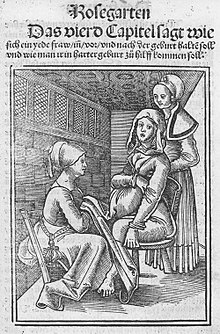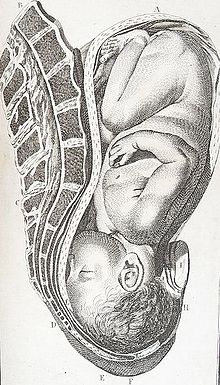Federal Writers' Project – Life Histories/2021/Summer/105/Section 06/Lula Russeau
Lula Russeau
[edit | edit source]Overview
[edit | edit source]Aunt Granny (Lula) Russeau was a midwife born in Alabama in the late 1800s. Russeau worked her entire life doing housework and being a midwife. Russeau was interviewed by the Federal Writers Project in 1939.
Biography:
[edit | edit source]Personal Life
[edit | edit source]
Aunt Granny (Lula) Russeau was born on August 15, 1861 in Alabama [1]. Russeau was a midwife who took care of women and helped deliver their babies. Russeau lived at 426 East Washington Street, Eufaula, Alabama. All of Russeau’s life she was taught to be a midwife. “God made me this way” (7) Russeau believes she was born to be a midwife and assist women during labor. She was raised to be independent and didn’t rely on anyone.[2] At home, Russeau’s mom never asked for the help of doctors. Russeau went on to marry Dave Russeau in 1878 but in 1936 she was a became a widow. Russeau had 11 children with Dave.[3]
Family
[edit | edit source]Her mother was Chickasaw Indian, born in Black Creek, Virginia. Russeau’s father was a “red man” born in South Carolina. Both of Russeau's parents had an American Indian Heritage. Russeau's mom raised Russeau on her own. Her mother taught her how to cook, clean, and take care of herself. Her mother made her own medicine with herbs and continued to teach Russeau how do to so. Pine tops and mullein leaves were used for bad colds, bitter weed for chills and fever, sage and catnip leaves for hives and so on. There were remedies with these herbs that were used on sick children and grown ups. These medicines and remedies were practiced throughout Russeau’s life. [4]
Social Issues
[edit | edit source]Midwifery
[edit | edit source]
In the late 80s and mid 90s, midwifery was at its peak. The enslaved Africans that were brought over by the Europeans to the US, within those the African women were trained as midwives and continued to train the other female slaves as midwives. “The terms midwife, granny-midwife, and granny were used to describe traditional Black midwives, who were well respected by their community and who still attended up to 75% of births in the 1940s in the Southeastern United States.”[5] This quote written in an article about midwives in the past, present, and future shoes how important and in demand midwives were. With little pay and a lot of responsibility midwifery is an emotionally and physically draining job. Some people may argue that midwives are safer than doctors. “In a clinical assessment that could have implications for the United States, Britain’s National Institute for Health and Care Excellence has concluded that it is safer for healthy women with uncomplicated pregnancies to give birth under the supervision of midwives than in a hospital maternity ward run by doctors. Doctors are much more likely than midwives to use interventions like forceps deliveries, spinal anesthesia and cesarean sections — procedures that carry risks of infection and surgical accidents” [6]“ Midwives attended approximately half of all births in 1900, but less than 15 percent by 1935. By the early 1930s most practicing midwives were black or poor-white granny midwives working in the south.” [7]
Women and housework in the 19th century
[edit | edit source]It’s pretty for a women to do housework maybe even stay home to take care of kids. When women didn’t have nearly as many rights housework wasn’t an option it was a job and a duty. From washing the clothes, cooking food, cleaning the house, and taking care of the kids, this was all the responsibility of a women. “Preparing even a simple meal was a time and energy consuming chore. Prior to the twentieth century, cooking was performed on a coal or wood burning stove. Unlike an electric or a gas range, which can be turned on with the flick of a single switch, cast iron and steel stoves were exceptionally difficult to use.”[8] This quote from an article demonstrates the difficulty of preparing a simple meal. It might seem easy to us now given all the advanced technology, but back in the 1800s and 1900s women didn’t have that. Everything happened from scratch. If anything needed to be warmed up, you couldn’t just pop it in a microwave. You would have to start a wood burning stove which takes much longer than just turning on a regular stove. These women would work all day long to insure everything was right at home.
Bibliography
[edit | edit source]Cara Terreri, CD (DONA). “Black History Month: The Importance of Black Midwives, Then, Now and Tomorrow.” Lamaze International. Lamaze International, February 14, 2020. https://www.lamaze.org/Connecting-the-Dots/black-history-month-the-importance-of-black-midwives-then-now-and-tomorrow-1.
Digital History. Accessed July 15, 2021. https://www.digitalhistory.uh.edu/topic_display.cfm?tcid=93.
“Folder 9: Couric, Gertha (Interviewer): Mid-Wives Are Called Grannies.” Federal Writers Project Papers. Accessed July 22, 2021. https://dc.lib.unc.edu/cdm/ref/collection/03709/id/921.
Rooks, Judith P. “The History of Midwifery.” Our Bodies Ourselves, 14 June 2016, www.ourbodiesourselves.org/book-excerpts/health-article/history-of-midwifery/.
“Board, The Editorial. “Are Midwives Safer Than Doctors?” The New York Times. The New York Times, December 15, 2014. https://www.nytimes.com/2014/12/15/opinion/are-midwives-safer-than-doctors.html. “
Staples, Brent. “How the Suffrage Movement Betrayed Black Women.” The New York Times. The New York Times, July 28, 2018. https://www.nytimes.com/2018/07/28/opinion/sunday/suffrage-movement-racism-black-women.html
Gordon, Linda, and Sara McLanahan. “Single Parenthood in 1900.” Journal of Family History 16, no. 2 (April 1991): 97–116.
Footnotes
[edit | edit source]- ↑ Lula Russeau, "Mid-wives are Called "Grannies"," Federal Writers' Project (1939): 54
- ↑ ibid.,54
- ↑ ibid.,55
- ↑ ibid.,154
- ↑ Gordon, Linda, and Sara McLanahan. “Single Parenthood in 1900.” Journal of Family History 16, no. 2 (April 1991): 97–116.
- ↑ “Board, The Editorial. “Are Midwives Safer Than Doctors?” The New York Times. The New York Times, December 15, 2014.
- ↑ Rooks, Judith P. “The History of Midwifery.” Our Bodies Ourselves, 14 June 2016
- ↑ Gordon, Linda, and Sara McLanahan. “Single Parenthood in 1900.” Journal of Family History 16, no. 2 (April 1991)